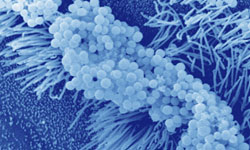Bacteria flourish in favorite ecosystems on the human body.
Study offers most comprehensive inventory yet of the human microbiome and a basis for understanding how those microbes affect health.
Source: Laura Sanders (http://www.sciencenews.org/view/generic/id/49242/title/Bacteria_flourish_in_favorite_ecosystems_on_the_human_body)

Like fussy first-time homebuyers, microbes in and on the human body choose their digs according to three strict rules: location, location, location. If the palm of the hand is a bustling metropolitan city crammed with hundreds of species, the ear canal is central Wyoming.
This variety is revealed by the most comprehensive inventory yet of the body’s microbial community. Reported online November 5 in Science, the research provides one of the most thorough whole-body maps to date of the estimated 100 trillion individual microbes the body harbors inside and out.
Assessing the body’s different microbial habitats will help researchers understand the intimate link between the human body and the microbiome — the bacteria, fungi and viruses that live in and on the body. These microbes — estimated to outnumber human cells by at least a factor of 10 — usually coexist with the human body in peaceful harmony, playing important roles in health, such as aiding digestion and preventing harmful infections. Understanding which microbes live where may help scientists understand how to treat people with disorders, including eczema and digestive disorders, that have been linked to specific kinds of bacteria.
“There’s so much unexplored territory in the human microbiome,” says Julia Segre, a biologist at the National Human Genome Research Institute in Bethesda, Md. “We need these kinds of baseline studies to know what to expect.”
The new study, which relies on DNA sequencing for the bacterial census, provides “an overview of the healthy human microbiota,” the researchers, led by Rob Knight and Elizabeth Costello, both of the University of Colorado in Boulder, write in the report.
Over the course of three months, Knight and his colleagues swabbed microbe samples from 27 bodily locales on or in seven to nine healthy volunteers at a time. Locations included ear canals, nostrils, mouths, lower intestines, navels, backs of knees, armpits, hair on heads, index fingers and palms. DNA sequences told researchers how many different kinds of bacteria resided in each spot. (Fungi and viruses, although part of the microbiome, weren’t analyzed in the study.)
Communities of bacteria living in one person’s distinct nooks and crannies were very different from each other, the team found. “It was really surprising to us just how little was shared at different sites on the same subjects,” Knight says. While some places, such as the navel, forehead and armpits, were colonized with few kinds of bacteria, other places, including the back of the knee, palm and forearm, had many different types of bacteria all living together. In fact, most people had at least one skin site with more diversity than that of the microbe-rich gut, the team found.
Comparing the bacterial profiles of volunteers to each other, the researchers found that overall, the microbiomes were highly personalized. Places such as the gut, hair, nostrils, ear canals and skin locations were very different from person to person. “People seem to be colonized by very different bacteria,” Knight says.

In a separate experiment, the researchers conducted a bacterial transplant experiment, in which the bacterial community from one locale was moved to another place (after sterilization) and tracked over several hours. This experiment tested how hospitable some body parts are to new bacteria, which are known to be sensitive to environmental factors such as oil, moisture and pH. Forearm bacteria didn’t thrive after a move to the forehead, the researchers found, and vice versa. Bacteria from a person’s tongue fared well on a forearm, but didn’t flourish on the forehead, suggesting that the oily forehead may be a harsher environment than the relatively dry forearm for some bacteria. Interestingly, the results were similar when participants received a transplant from their own body and when participants received a bacterial transplant from a different person.
“I’ve never seen anything like this,” Segre says of the transplant study. “It’s really novel.” Moving bacterial locations may mimic what’s happening in hospital settings and personal settings, such as when someone plants a wet kiss on a cheek, Segre says. “There really is a lot of microbiome sharing going on.”
The researchers also monitored how bacteria communities changed in people over time. As expected, bacteria in the relatively isolated belly button remained fairly constant over the three months of the study. But bacteria in other regions also remained fairly constant over time, Knight says, supporting the idea that people have resilient, predictable “biogeographical patterns” of bacteria.
Knight says it would be fascinating to see how the bacterial profiles of people change from culture to culture. “How do these results hold up among populations that are both genetically and culturally different?” he says.
The job of characterizing all of the human microbiome is far from over, Knight says. A consortium of scientists is currently working on the
Human Microbiome Project, which aims to comprehensively map the human microbiota. Some scientists working on the project plan to catalogue the microbiomes of 250 healthy volunteers, expanding significantly on Knight’s study.
Other aspects of the Human Microbiome Project focus on understanding what roles microbes have in both maintaining good health and causing diseases. Properties of the individual human microbiomes may contribute substantially to diseases such as eczema, psoriasis, obesity and inflammatory bowel disease.
Comments (0)
You don't have permission to comment on this page.